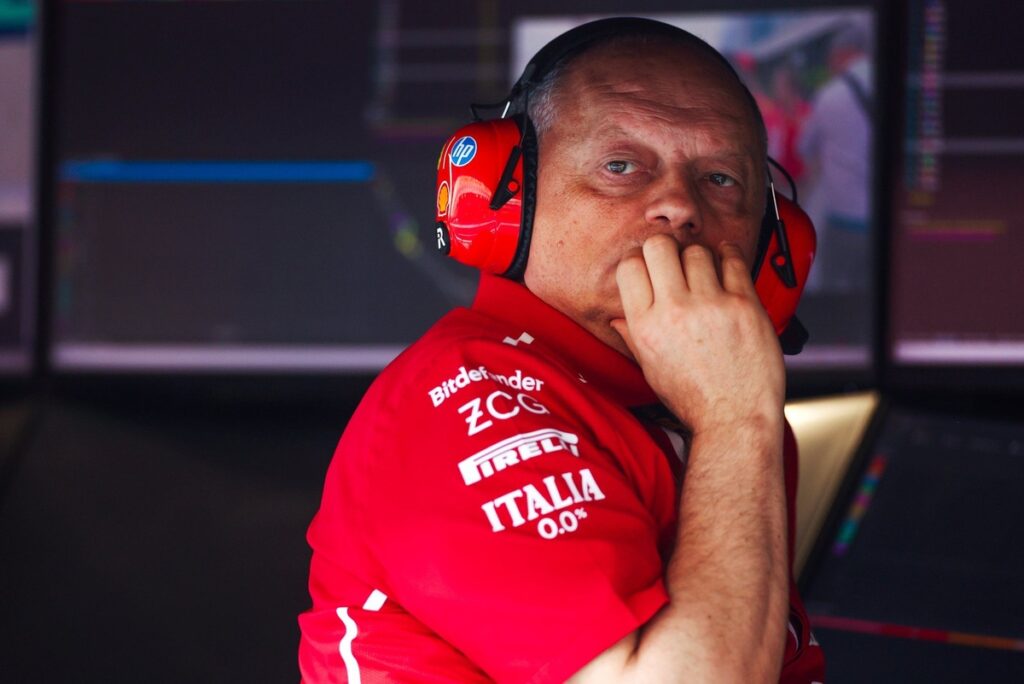“It’s basically the same as it’s been for three years,” Ferrari team principal Frederic Vasseur said of Ferrari’s engineering setup while facing questions from the media ahead of the 2025 Imola GP.
“We’ve made some mistakes with the car, but we know where to improve.”
The line of questioning directed at Vasseur is not new in motorsport, nor at Ferrari’s Maranello HQ. If a car doesn’t live up to expectations, who is responsible? And can one hope that a technical department will produce a winning project if it features the same people involved in one which has fallen short?
Lewis Hamilton’s sprint race win in China is the outlier in a season in which Ferrari is lagging badly – fourth in the constructors’ standings and 152 points behind the leading McLaren team. The indifferent performance on track has been shadowed by a wave of negativity regarding the SF-25 and its genesis.
When things go wrong on track, the reaction in the outside world begins with analysis and soon shifts to the people behind the project. At Imola, Vasseur was asked whether there is full confidence in the technical staff working on the 2026 car. In response, he was precise in clarifying the position of Loic Serra, the technical director who joined from Mercedes last October to replace Enrico Cardile, who remains on ‘gardening leave’ pending a move to Aston Martin.
“When Loic arrived in Maranello six months ago, the current car was already, let’s say, 90 percent defined,” Vasseur said. “Then, of course, it depends on individual elements, but the key decisions behind the project had already been made.
Loïc Serra, Ferrari
Photo by: Ferrari
“I mean the weight distribution, the wheelbase, the general concept, and so on. This is something that affects all teams when there’s a change in technical leadership.”
The message is clear: when Serra arrived in Maranello, he inherited the foundations laid by Cardile. But if the SF-25 is not Serra’s project, the same goes for Cardile, who left Maranello on July 8. In fact, the current car has no real ‘father’, if by parent we mean a technical director responsible for the project.
“On the other hand, 95% of the team is the same as the one that worked on the 2023, 2024 and 2025 projects. I’m convinced that just because a project has problems doesn’t mean the structure isn’t working,” said Vasseur.
“I have great confidence in our working group – we know we need to improve, but that’s a constant in motorsport. Even if you’re leading, you know you must keep improving, otherwise you expose yourself to attacks from rivals.
“As for this year, we’ve probably made some mistakes with the car. We need to do a better job, but the motivation is there and the mindset is there. I’m sure we just need to keep growing [as well as] identifying and solving problems.”
Vasseur rejects talk of abandoning SF-25 development in favour of the 2026 project and remains convinced that beyond the development plan (which is to introduce major updates during the Spanish Grand Prix weekend), the team has yet to fully exploit what it has at its disposal.
“We often end race weekends with the feeling that we haven’t extracted the maximum from the car. As long as we have that feeling, I can’t say I know the exact potential of the project.
“That’s why I believe there are still signs there is room for improvement.”
In this article
Roberto Chinchero
Formula 1
Be the first to know and subscribe for real-time news email updates on these topics
Subscribe to news alerts
Read the full article here

